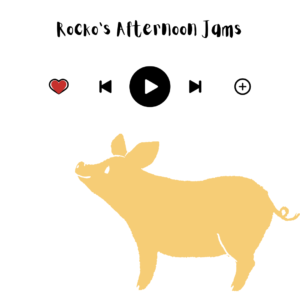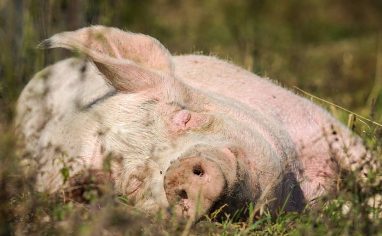
Non-Compassionate Sources
We at The Open Sanctuary Project disavow animal experimentation and any “use” of animals for human purposes. Because compassionate studies on valuing the personality, intelligence, and unique attributes of many nonhuman animals are rare, in this resource, we draw from existing work that may be non-compassionate but may, all the same, be used to improve the lives of residents. We work towards a future when compassionate, non-exploitive, and non-invasive research is the norm. Still, in the meantime, we will work with what we have to help sanctuaries help animals as effectively as possible. You can read a little bit more about our non-compassionate source policy here.
Music For Pigs: The Right Tune Can Promote Wellbeing
Welcome to our second resource in our Science For Sanctuaries series! If you care for pigs, you have likely found yourself brainstorming creative ways to improve the lives of pig residents. In this resource, we will review what is known about how music may affect pig residents and how a better understanding of this could help you provide better care for pig residents. Is music good for pigs? We know that different types of music can have varying effects on humans and other animals, both positive and negative.1,2,3,4 Does the type of music matter? Can it affect behavior or emotions? While research addressing these questions does exist, more research is needed. However, some studies indicate that music may be beneficial in a caregiver’s toolbox for promoting positive welfare for pig residents. In this resource, we will briefly examine the current research available and whether the findings have application in sanctuary settings. Let’s take a look at the research:

A Pig’s Relationship With Sound
If you have experience caring for pigs, you know they have an impressive number of vocalizations they use to communicate with one another.5,6 These vocalizations range from deep soft grunts to high-pitched squeals and others. Pigs use their good sense of hearing to listen and interpret these vocal communications. Pigs also use their hearing to distinguish between different caregiverSomeone who provides daily care, specifically for animal residents at an animal sanctuary, shelter, or rescue. voices.7,8 This good sense of hearing is something that caregivers should consider while providing daily care. We know loud, sudden noises or continuous irritating noise (like construction or yelling) can negatively affect pig residents.9,10 Care must be taken in a sanctuary environment to limit their exposure to such negative stimuli.
The Research
There are several studies researching music’s effect on pigs. Sadly, much of this is exploitative and viewed through an agricultural lens. However, we hope to use the existing knowledge to help pigs receive more compassionate care through a sanctuary lens. Let’s look closer at some of the available research:
Vivaldi Reduces Stereotypical Behaviors And Promotes Relaxations11
In this study, Antonio Lucio Vivaldi’s compositions were played for pigs housed alone, in limited space, and for pigs housed together. They studied whether the music would affect their activities, presence of stereotypies, and social and confrontationalBehaviors such as chasing, cornering, biting, kicking, problematic mounting, or otherwise engaging in consistent behavior that may cause mental or physical discomfort or injury to another individual, or using these behaviors to block an individual's access to resources such as food, water, shade, shelter, or other residents. behaviors. They found that music reduced stereotypic behavior and promoted states of relaxation, and resulted in fewer negative reactions when humans checked their vital signs. They concluded that this type of music could improve individuals’ welfare.
Effect Of Auditory Enrichment (Music) In Pregnant Sows Welfare | Engenharia Agrícola
Mozart Promotes Well-Being And Improved Immune Function12
In this study, 72 piglets, divided into three groups, were played either Mozart compositions, mechanical sounds, or nothing. They found increased activity and less lying behavior in groups who had been listening to Mozart or mechanical sounds. The group listening to Mozart showed increased playing, tail-wagging, and explorative behaviors, while those listening to mechanical sounds showed an increase in confrontational behaviors. Over two months, these confrontational behaviors, along with play, tail-wagging, and explorative behaviors, decreased. Those listening to Mozart had lower cortisol levels than others and when they had been listening daily for two months exhibited physiological measures associated with enhanced immune system responses. The pigs listening to mechanical noise showed increased confrontational behaviors and reduced immunity. This indicates that Mozart may have a positive effect on pig residents while “noise” could lead to negative experiences for residents.
Slow-Tempo String Music And Fast-Tempo Wind Music Promote Positive Moods13
This study exposed piglets to slow-tempo string and fast-tempo wind music and recorded behavior and physiological responses. They found that it promoted positive moods indicated by increased tail-wagging and play behaviors and slow-tempo string music positively influenced immunomodulation (a positive change to the immune system). They did not find any differences in the piglets’ growth or stress response.
Music And Pink Noise Do Not Reduce Piglet Vocalizations14
The following study concluded that music and “pink” noise did not reduce piglet vocalizations (a measure of welfare) during stressful interactions such as being held for a stressful procedure or 20 hours after weaning. Unfortunately, we couldn’t access the full study, so we don’t know what type of music, handling, or weaning techniques were used or what environmental factors came into play.
Music Can Be A Tool To Promote Positive Feelings In Piglets15
In this study, researchers explored whether music, Bach (prelude cello suite no 1) and two pieces from Sir Edward Elgar (cello suite and nimrod), could facilitate play behaviors in piglets after being weaned. They connected the presence of music with access to a playroom (considered a rewarding experience and confirmed by increased play behavior). Piglets who hadn’t been weaned were played music when given access to a playroom. Then, after weaning, they were played the same music, and researchers observed the presence of the music encouraged play behavior even in the absence of access to the playroom. However, to a lesser degree, they found that piglets who played the same music that was not given access to a playroom also exhibited more play behaviors. This could be due solely to the music, or it could be that the sounds of the other piglets playing inspired play behavior amongst themselves as well. This study essentially created a mental connection between classical music and access to a rewarding space. Playing music still promoted playful behavior when the rewarding space was no longer available.
Pigs Don’t Dig Rock N Roll16
In this study, three groups of pigs were fed while either listening to no music, slow rhythm music, or fast rhythm music (rock and roll). The pigs that played rock and roll gained less weight than those who played no music or slow rhythm music. This study revealed that rhythm, not just noise level, could affect pigs, as both slow and fast rhythmic music was played at the same volume level.
Effect Of Music Rhythm On Growth Performance Of Growing Pigs | Agriculture And Natural Resources
Music Sets The Mood: Pigs Experience Different Emotions In Response to Different Music17
In another study, researchers concluded that piglets respond emotionally to different types of music. Pigs respond positively to harmony and negatively to inharmonious music. Piglets listened to multiple compositions. Some of these had multiple instruments that were either inharmonious or harmonious. Another was simply a single instrument, therefore lacking either harmony or dissonance. They found a wide variation in emotional responses between harmonious and dissonant musical compositions. Emotional responses to harmonious music were mostly positive, including playful, sociable, happy, content, positively occupied, and lively. Emotional responses to dissonant music were mostly negative, including fear and uneasiness. Emotional responses to the single instrument composition included calm, relaxed, and indifferent.
Music Modulates Emotional Responses In Growing Pigs | Scientific Reports
Tempo Affects Behavioral Responses In Piglets18
This study sought to find whether piglets had different responses when listening to different types of music. In this case, the musical options were slow-string instrumental music, fast-string instrumental music, slow-wind instrumental music, and fast-wind instrumental music. Piglets were given the option to spend time in a room where no music was playing and one where one of the 4 types of music was playing. Piglets spent more time in the room where music was played, specifically when slow string music and fast wind music were playing. Several behavioral differences were observed compared to piglets who were not listening to music. When listening to slow string music, piglets exhibited more lying behavior and exploration. When listing to fast-string music, piglets were observed wagging their tails more. Slow-wind music increased exploratory behaviors, and fast-wind music increased walking, lying, standing, and exploration. When looking specifically at the tempo (slow or fast), piglets exhibited more walking, standing, and tail-wagging behavior when listening to fast-tempo music than when listening to slow-tempo music.
Behavioural Responses Of Piglets To Different Types Of Music | Animal
Limitations Of These Studies
The number of piglets in 2 studies was quite small (15 and 28 individuals). The more individuals studied, the more data we have. The more data we have, the more confident we can be about the soundness of the findings. Some of these studies also had contradictory results, though this may be due to their different methods or the conditions under which they gathered data. Additionally, some studies generalized genres of music, not exploring different songs in the same genre, and made conclusions that may prove different in a similar study using different songs.
While we can confidently determine that music does affect pigs and, in some cases, has a positive effect, more compassionate, non-exploitative studies are needed to determine the effectiveness of different types of music in different circumstances. For now, many of these studies demonstrate certain types of music as promising instruments in promoting the well-being of pig residents.

Practical Applications For Sanctuaries
Use Caution
We cannot stress enough the importance of considering each individual, their history, temperament, social relationships, and health, and the importance of paying close attention to resident responses to any newly introduced enrichment. We do not know the full effects different types of music may have on pig (or other) residents. What is enjoyable for one may be distressing for another resident. Some individuals may be more sensitive to sounds than others. It’s important to consider the possible risk factors. Sudden loud music blaring could frighten residents, causing them to panic and injure themselves or others trying to escape. Use caution and present music at lower volumes, gradually increasing it to a comfortable level while observing and recording behavior. Expand your exploration, and if a volunteer or staff member can play an instrument, have them play a little something and see if anyone has preferences for different instruments.
Using music to enrich the lives of pig residents is a promising aid. It is also inexpensive and easy to control. There are a variety of situations where caregivers may find the use of music helpful in improving the well-being of pig residents. Here are just a few:
- To encourage activity and exploratory behavior when a resident needs to move around more
- To encourage play behavior
- In quarantine spaces for new residents
- To reduce social friction
- To provide stimulation for residents who must be temporarily separated
- As general sensory enrichment and novelty
Sanctuary Scientists
Sound, reliable research requires a solid framework and controlled studies covering many details to collect valid data and provide accurate results. Controlled studies will try their best to ensure that every possible factor is kept the same for each individual or group, except the individual or group being studied, who will have a single different factor introduced to them. You can learn a little more about controlled studies here. You can be a sanctuary scientist and learn more about your residents and how best to meet their needs!
Compassionate Science Only
We have mentioned it before, but this can’t be overstated: We at OSP fundamentally disavow animal experimentation and any “use” of animals for human purposes. No resident should ever be forced into a situation that might cause them harmThe infliction of mental, emotional, and/or physical pain, suffering, or loss. Harm can occur intentionally or unintentionally and directly or indirectly. Someone can intentionally cause direct harm (e.g., punitively cutting a sheep's skin while shearing them) or unintentionally cause direct harm (e.g., your hand slips while shearing a sheep, causing an accidental wound on their skin). Likewise, someone can intentionally cause indirect harm (e.g., selling socks made from a sanctuary resident's wool and encouraging folks who purchase them to buy more products made from the wool of farmed sheep) or unintentionally cause indirect harm (e.g., selling socks made from a sanctuary resident's wool, which inadvertently perpetuates the idea that it is ok to commodify sheep for their wool). for the sake of knowledge. Ensuring residents are not emotionally, mentally, or physically discomforted or harmed is paramount in compassionate science. An example of compassionate science at sanctuaries may look like this:
– Giving residents choices to learn their preferences. For example, do Bongo, Steph, and Jilly prefer to spend time where music is playing or not playing? Do you observe any behavior changes when they are exposed to different types of music? Does their heart rate, respiratory rate, or vocalizations change?
The best way to practice compassionate science in many situations is to let the residents choose. If they indicate they don’t like music, take it away or ensure they have the choice to walk away from it. Ideally, you are just offering them the option to participate in an activity or interact with something if they find it neutral or positive.
Remember, the goal of sanctuary science is to better the individual’s life! Purposefully putting residents in potentially harmful situations, whether emotionally, mentally, or physically harmful, is unacceptable. Let’s make science what it should be – compassionate and non-exploitive!
What Does ‘Unacceptable’ Mean?
At The Open Sanctuary Project, unacceptable means that we cannot condone (or condone through omission) a certain practice, standard, or policy. See a more detailed explanation here.
Where To Start?
While a lot goes into setting up a well-controlled experiment, you can start by introducing slow, classical music at a lower volume and observing any changes in behavior, observing and recording behavior both before and after. We recommend repeating the “experiment” several times in the same context for more reliable results. Before you do all of this with the music, however, we recommend you go through the same motions without the music and record those results first. If you walk to a specific area to set up the music, do that without playing any music first and record the behavior. That way, you know if their responses are due to your presence in a certain area or due to the music.
Limit Variation!
We mentioned repeating the study under the same context as a vital factor. It is important to control as much of the environment as possible to limit any interruptions or inaccurate findings. If repeating this research over a series of days, you must replicate the environmental factors as much as possible. Otherwise, this can affect the results you get and not provide you with accurate data. This is because a new factor can affect the results you might get.
Here are some examples of things that should ideally be the same:
- Time of day
- Same caregiver
- Same social situation
- Same weather
- Same music
- Same volume
- Same location/sights
- Same food
- Same status of the resident’s health
Write It Down!
If you notice a resident responding positively to music, be sure to write down the type of music or song being played. Take note of the volume and other environmental factors, such as the time of day, whether they have eaten, their companions, and any occurrences that day. That way, you can create a favorites list: Rocko’s Afternoon Jams!

One Last Thing
Remember the individual. What works for one resident doesn’t necessarily for another. They have personal preferences and dislikes. A resident may find a specific type of music (or all music) unpleasant. Always be on the lookout for any signs of avoidance or behavior indicating stress or anxiety, and be ready to lower the volume, change the music, or remove the music altogether to ensure they can walk away from it.
We hope you find these bite-sized science resources helpful at your sanctuary. These resources aim to provide sound scientific information that may have a practical application in sanctuaries. We hope you’ll stay tuned for more Science For Sanctuaries. If you haven’t yet, check out our resource exploring the research on lavender and horses. In the meantime, let us know if you have any experience with music for pig residents or other resident species. We love hearing from you and will do our best to answer any questions! Also, please contact us if you have any questions or concerns. It is important to us to continuously improve our knowledge base with the most accurate, compassionate information possible.
SOURCES:
- Emotional Reactions Mediate The Effect Of Music Listening On Creative Thinking: Perspective Of The Arousal-And-Mood Hypothesis | Frontiers In Psychology
- Fast And Loud Background Music Disrupts Reading Comprehension | Psychology Of Music
- Effects Of Music On Behavior And Physiological Stress Response Of Domestic Cats In A Veterinary Clinic | Journal Of Feline Medicine And Surgery
- Sensory Stimulation As Environmental Enrichment For Captive Animals: A Review | Applied Animal Behaviour Science (Non-Compassionate Source)
- Pig Sounds Are Associated With Emotions, Scientists Found | The Washington Post (Non-Compassionate Source)
- Mini PigThe term “mini pig” is used to categorize smaller breeds of pigs, such as Potbellies, Julianas, and Kunekunes, and to differentiate between these breeds and large breed pigs, such as Yorkshires, Landrace, or Hampshires, who are sometimes referred to as “farm pigs”. The descriptor “mini” can be a bit misleading- some breeds of mini pigs can weigh over 200 pounds! Terms like “teacup”, “micro”, “pocket”, “nano”, and “micro mini” are deceptive terms that are sometimes used to intentionally mislead people into thinking an individual pig will remain a certain size. Noises With Sound Recordings | Life With A Mini Pig
- Domestic Piglets (Sus Scrofa Domestica) Are Attentive To Human Voice And Able To Discriminate Some Prosodic Features | Applied Animal Behaviour Science (Non-Compassionate Source)
- Pig–Human Interactions: Creating A Positive Perception Of Humans To Ensure Pig Welfare | Advances In Pig Welfare (Non-Compassionate Source)
- Behavioural And Physiological Responses Of Pigs To Sound | Applied Animal Behaviour Science (Non-Compassionate Source)
- Horses And Pigs Sense Harsh Speaking Tones | Science Daily (Non-Compassionate Source)
- Effect Of Auditory Enrichment (Music) In Pregnant Sows Welfare | Engenharia Agrícola (Non-Compassionate Source)
- Effects Of Music Stimulus On Behavior Response, Cortisol Level, And Horizontal Immunity Of Growing Pigs | Journal Of Animal Science (Non-Compassionate Source)
- Effects Of Long-Term Exposure To Music On Behaviour, Immunity And Performance Of Piglets | Animal Production Science (Non-Compassionate Source)
- Can Ambient Sound Reduce Distress in Piglets During Weaning and Restraint? | Journal Of Applied Animal Welfare Science (Non-Compassionate Source)
- Music During Play-Time: Using Context Conditioning As A Tool To Improve Welfare In Piglets | Applied Animal Behaviour Science (Non-Compassionate Source)
- Effect Of Music Rhythm On Growth Performance Of Growing Pigs | Agriculture And Natural Resources (Non-Compassionate Source)
- Music Modulates Emotional Responses In Growing Pigs | Scientific Reports (Non-Compassionate Source)
- Behavioural Responses Of Piglets To Different Types Of Music | Animal (Non-Compassionate Source)
Non-Compassionate Source?
If a source includes the (Non-Compassionate Source) tag, it means that we do not endorse that particular source’s views about animals, even if some of their insights are valuable from a care perspective. See a more detailed explanation here








